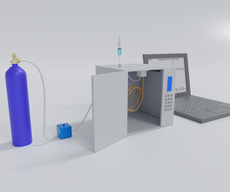Retention Time Trajectory Matching for Peak Identification in Chromatographic Analysis
TECHNOLOGY NUMBER: 2021-241

OVERVIEW
Creation and validation of the retention time trajectory method (RTT) for describing chromatographic peaks- Includes matching between entire chromatographic trajectories rather than just peaks
- Permits the use of simple statistics that do not require resource intensive training or feature extraction
BACKGROUND
Gas chromatography (GC) is utilized in analytical chemistry to separate and analyze compounds that can be vaporized without decomposition. Its most common uses include testing purity of a substance or separating out different components of a mixture. GC may be classified either as untargeted or untargeted, depending upon whether the chemical substances are known prior to analysis. In targeted analysis, the retention time of each peak reading in the GC chromatogram is compared with pre-installed values of all compounds of interest in an existing library of measurements. If the retention time of a peak matches one of the pre-installed values, then the result is reported. Conversely, if the retention time of a peak does not match any pre-installed values, then the peak is ignored or reported as interferent.
Variations in physical factors such as temperature and carrier gas flow rate can cause peak drifts in a chromatogram from run to run, which can either hinder peak identification or trigger false alarms. Proper matching or alignment of chromatographic peaks across different samples can be undertaken by dividing the data into histograms and incorporating all data in a recognition profile for each measurement, though this method suffers from reduced resolution in the presence of large peak drifts. An alternative yet more costly approach involves the use of machine learning based analyses, though these approaches are most suitable for bulky mass spectrometry-based analysis rather than onsite monitoring. Given that retention time drifting is ubiquitous in chromatographic measurement and existing analytical methods are imperfect, a need exists for a less costly and more reproducible means by which to evaluate chromatographic data.
INNOVATION
Researchers have created and validated a concept called retention time trajectory (RTT) that combines and describes a series of chromatogram peaks occurring under a specific set of experimental conditions. RTT uniquely represents a chromatogram in a 2-dimensional diagram which compares the RTT obtained from the sample chromatogram with those stored in an existing library. The main features of this approach include matching between entire trajectories rather than individual peaks in the sample and reference chromatograms, the use of simple statistics that do not require resource intensive training or feature extraction, and hybridization of RTT libraries (RTTlib) to reduce costs for RTTlib generation through actual experiments. In this setting, each hybridized RTTlib is generated from two experimentally derived RTTlibs.
Moving forward, a larger number of experimentally obtained RTTlibs could be involved, and the linear coefficients could be further tuned depending on the complexities of the subjects to be analyzed. Additionally, since this methodology only measures input variables at the apex positions of each peak rather than the whole peak profile or mass spectra, it can negate sensitivity to concentration or background and eliminates the need for bulky instruments such as those associated with mass spectroscopy. While the simple RTT matching approach cannot be universally applicable to all kinds of samples in a targeted analysis, it is amenable to automation with low computation costs and can be broadly applied to gas chromatography, liquid chromatography, and other spectroscopic techniques, as well as chromatogram profile aligning.